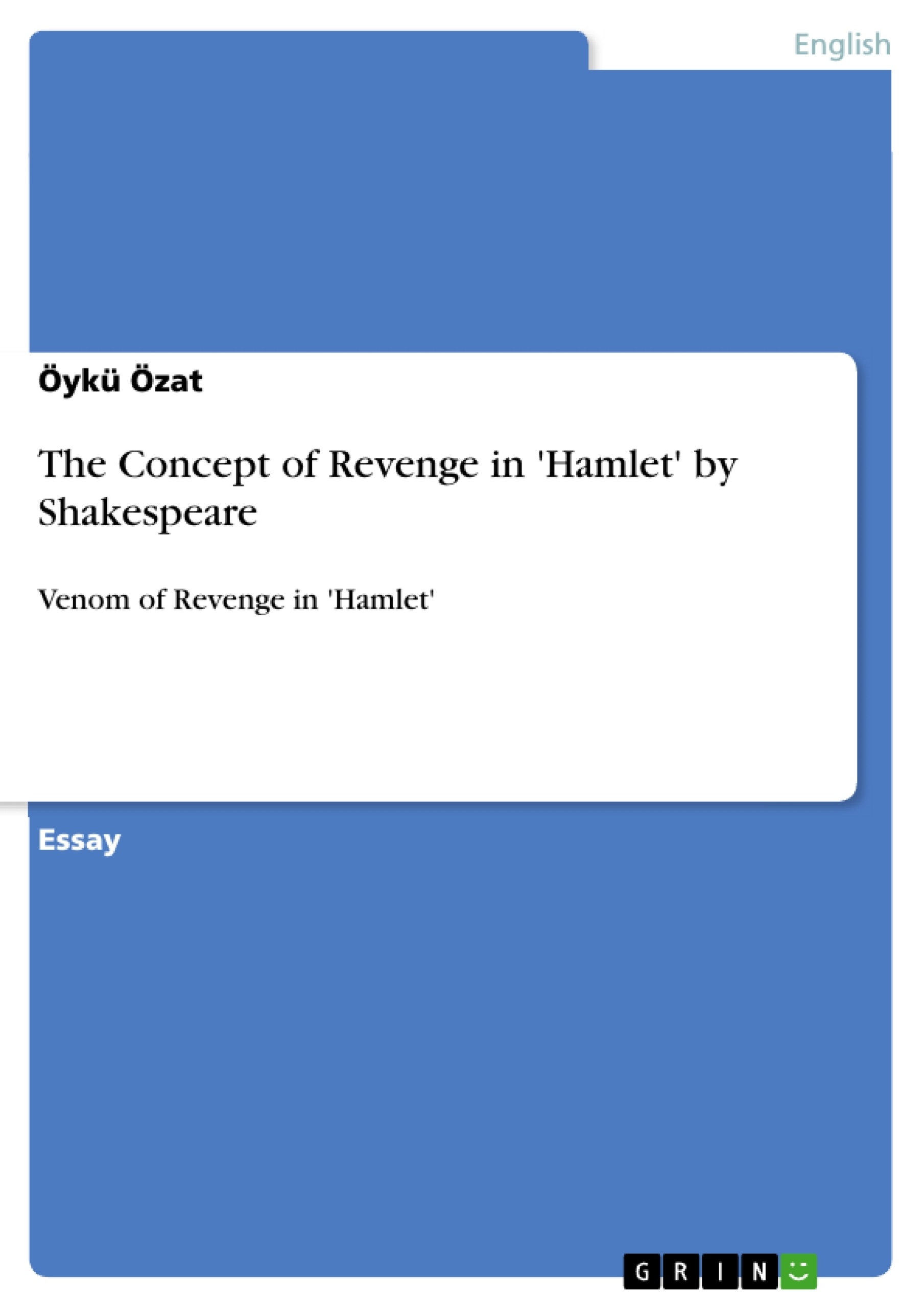This study intends to analyse not only the concept of revenge, how universal and motivating is this feeling but also how justifiable is it through the lens of the characters in 'Hamlet'.
Table of Contents
- Fever of Revenge
- Hamlet's Revenge
- Laertes' Revenge
- Fortinbras' Revenge
Objectives and Key Themes
This study analyzes the concept of revenge in Shakespeare's Hamlet, examining its universality, motivating power, and justifiability through the actions and motivations of Hamlet, Laertes, and Fortinbras. The analysis explores the consequences of revenge, both for the individuals seeking retribution and for those around them.
- The universality and psychological impact of revenge
- The consequences of impulsive versus deliberate action in seeking revenge
- The role of morality and justice in the pursuit of revenge
- Comparison of revenge motives and actions across multiple characters
- The interplay between personal ambition and the desire for revenge
Chapter Summaries
Fever of Revenge: This chapter explores the nature of revenge as a powerful, tempestuous emotion inherent in human nature. It discusses revenge as a form of primitive justice, a temporary pleasure often leading to worse outcomes, and its universality as depicted across various works of literature, including Shakespeare's Hamlet. The chapter highlights the inherent human tendency towards revenge, emphasizing its presence throughout history and across cultures.
Hamlet's Revenge: This section delves into Hamlet's quest for vengeance after learning of his father's murder. Hamlet's indecisiveness and moral struggles are central to the analysis, highlighting his internal conflict between the desire for revenge and his conscience. His hesitation to kill Claudius while praying demonstrates his internal conflict and ultimately contributes to the tragic consequences. The chapter also touches upon the potential motivations of throne-related ambition intertwined with his desire for revenge.
Laertes' Revenge: This chapter examines Laertes' reaction to his father's death and his immediate and decisive pursuit of revenge against the perceived murderer, King Claudius. Unlike Hamlet's prolonged internal struggle, Laertes acts impulsively and recklessly, which leads to his downfall. The chapter contrasts Laertes' swift and decisive actions with Hamlet's hesitancy, highlighting the differing consequences of their approaches. Laertes' actions are fueled by grief and a thirst for retribution, contrasting with Hamlet's more complex motivations.
Fortinbras' Revenge: This section analyzes Fortinbras' ambition and his drive to conquer Denmark as a form of revenge for his father's death. Fortinbras' ruthless pursuit of power and disregard for human life distinguishes him from both Hamlet and Laertes. The chapter contrasts Fortinbras' focus on military conquest with the moral dilemmas faced by Hamlet and Laertes. His ambition, devoid of the moral complexities experienced by Hamlet, ultimately highlights a different facet of revenge's motivations.
Keywords
Revenge tragedy, Hamlet, Shakespeare, Laertes, Fortinbras, revenge motivation, moral dilemmas, indecisiveness, impulsiveness, ambition, consequences of revenge, justice, morality, tragedy.
Shakespeare's Hamlet: Revenge Tragedy - FAQ
What is the main focus of this academic preview?
This preview provides a comprehensive overview of a study analyzing the theme of revenge in Shakespeare's Hamlet. It examines the concept of revenge through the actions and motivations of Hamlet, Laertes, and Fortinbras, exploring its universality, driving force, justifiability, and consequences.
What are the key themes explored in the study?
The study explores the universality and psychological impact of revenge, the consequences of impulsive versus deliberate actions, the role of morality and justice in the pursuit of revenge, a comparison of revenge motives and actions across different characters, and the interplay between personal ambition and the desire for revenge.
What chapters are included in the study, and what do they cover?
The study includes chapters on: "Fever of Revenge" (exploring the nature of revenge as a powerful emotion), "Hamlet's Revenge" (analyzing Hamlet's internal conflict and indecisiveness), "Laertes' Revenge" (examining Laertes' impulsive pursuit of revenge), and "Fortinbras' Revenge" (analyzing Fortinbras' ambition and ruthless pursuit of power).
How does the study compare and contrast the characters' approaches to revenge?
The study contrasts Hamlet's prolonged internal struggle and moral dilemmas with Laertes' impulsive and reckless actions, and both with Fortinbras' ambition-driven, ruthless pursuit of power. It highlights the differing consequences resulting from their approaches to revenge.
What are the key takeaways from the analysis of each character's revenge?
The analysis of Hamlet highlights his internal conflict between revenge and conscience; Laertes exemplifies the dangers of impulsive action; and Fortinbras illustrates the ruthlessness of ambition-fueled revenge, devoid of moral complexity. Each character's approach provides a unique perspective on the multifaceted nature of revenge.
What are the key words associated with this study?
Key words include: Revenge tragedy, Hamlet, Shakespeare, Laertes, Fortinbras, revenge motivation, moral dilemmas, indecisiveness, impulsiveness, ambition, consequences of revenge, justice, morality, and tragedy.
What is the overall objective of this academic work?
The overall objective is to provide a thorough analysis of revenge as a driving force in Shakespeare's Hamlet, exploring its various manifestations, motivations, and consequences within the context of the play's characters and their actions.
What type of audience is this study intended for?
This study is intended for an academic audience interested in Shakespearean drama, literary analysis, and the theme of revenge. The structured and professional approach suggests its suitability for scholarly research and analysis.
- Quote paper
- Bachelor Öykü Özat (Author), 2021, The Concept of Revenge in 'Hamlet' by Shakespeare, Munich, GRIN Verlag, https://www.grin.com/document/1001706




